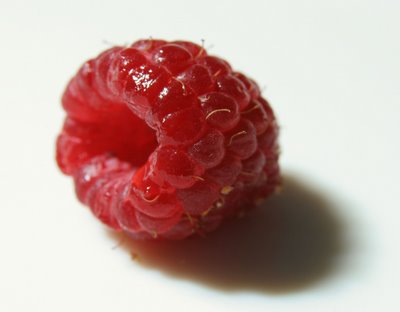Getting nice sharp macro shots with an SLR camera can be very difficult due to the extremely narrow area of focus when you move your camera so close to the usually very small object. This problem is, of course, compounded when there isn't enough light and you want to keep the aperture wider. So it would be very nice to use a flash in macro photography to allow you to get greater depth of field with a smaller aperture. "So what?" you say, "just turn on the flash." Ah, but the next problem presents itself. When your camera is a few inches away from a flower the flash does not point at or hit the flower. It isn't designed to light objects that are right in front of the lens. Hence an off the camera flash or some way of bouncing or directing the flash is necessary. For the following shots I've used a Quantaray 6500 flash and a 9500 flash with a variety of different modules (one that I got to use with my old Pentax Spotmatic, one for a Nikon Manual Focus, and One for Canon Auto Focus that will only work if you cover one of the contacts with electrical tape, more on that later). In order to get the flash off the camera you either need a dedicated sync cord (usually about $50) or with this Quantaray system you can buy the QPH 5000 flash handle (holds batteries and integrates with module and flash) from your local Ritz, Kitz, or Wolf Camera store for about $25, or you can find a dozen flash and handle combinations on ebay for between $10 and $40. That is for the flashes that do not integrate with your Canon (and I assume Nikon would be similar) integrated TTL (Through The Lense) or ETTL or iTTL or whatever they call the auto flash exposure system. If you are on a budget and you want to play around with flashes these quantaray flashes are really quite a deal--especially on Ebay. Most of the modules will allow you to use the flash with at least two different power output settings-- full and 1/16th. I regulate the brightness of the flash by setting the camera to full manual mode, set the ISO to 200, set the shutter speed to 60, and then change the F-stop and the distance/ bounce of the flash to adjust the brightness for each situation. Of course, digital makes this process to much easier, since you can take one frame and then look at it to evaluate the exposure.
Now for the specifics of these pictures.
This is a rasberry on a plate. The white plate provides a nice background and the off the camera flash allows me to creat a nice sidelit macro with a very distinct shadow. I would not have anything worth looking at if I had taken this picture without a flash. Of course, you could accomplish the same thing with a plate in bright sunlight.

This flower, a zinnia, is also lit from the side and above--a generally nice lighting angle. Being able to control the lighting allows you to experiment and play around to see what looks good.

I am not a big fan of macro photography, but this photo (below) kindled a new interest in the small world for me. The little flames that show up at the center of the flower are stunning and beautiful. You have to look very closely in real life to see them.

 This flower, a zinnia, is also lit from the side and above--a generally nice lighting angle. Being able to control the lighting allows you to experiment and play around to see what looks good.
This flower, a zinnia, is also lit from the side and above--a generally nice lighting angle. Being able to control the lighting allows you to experiment and play around to see what looks good. I am not a big fan of macro photography, but this photo (below) kindled a new interest in the small world for me. The little flames that show up at the center of the flower are stunning and beautiful. You have to look very closely in real life to see them.
I am not a big fan of macro photography, but this photo (below) kindled a new interest in the small world for me. The little flames that show up at the center of the flower are stunning and beautiful. You have to look very closely in real life to see them.
No comments:
Post a Comment